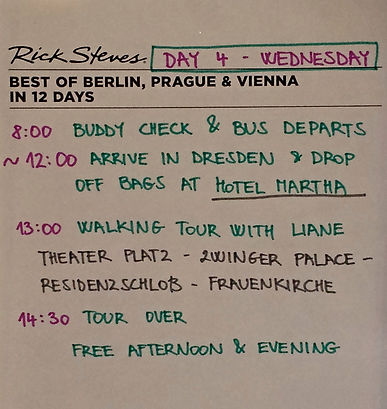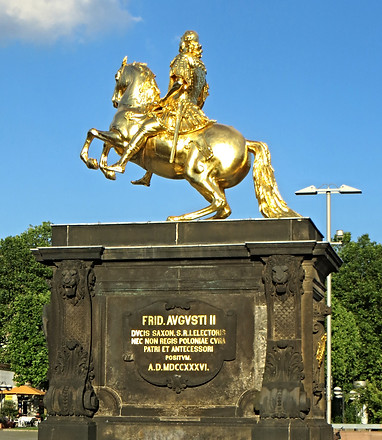
We arrived in Dresden around 11:30am and checked into the charming Hotel Martha. We quickly met back up with the group and walked to the Old Town to meet our local guide, Liane, for a walking tour. It was immediately obvious that Dresden was smaller and more intimate than Berlin. This is one of the things that we love about Rick Steves tours--the nice mix of larger, faster paced cities and smaller towns that let you slow down and catch your breath. Dresden is divided by the Elbe River into a "new town" and "old town." Pretty much everything in the old town was destroyed during the February 1945 allied firebombings. If it looks old, it was likely rebuilt to look that way.
Liane oriented us to the old town, showing us the Opera House (Semperoper) where works by Richard Wagner and Richard Strauss premiered. We walked around the magnificent Zwinger Palace Complex. Augustus the Strong, having converted to Catholocism and been crowned King of Poland, initiated building of the Zwinger Palace in 1710 (he had Versailles envy). This grand complex was the place to party for the Wettin dynasty and their guests. It is full of beautiful fountains and statuary and must have been an amazing place to hang out with the royals. Today it houses several museums. As we were taking a rest and admiring our beautiful surroundings, Jana returned with another treat (she was always sneaking off and returning with surprises for us). She purchased several pieces of Eierschecke, a Dresden specialty. It is a three layer cake made with eggs and custard (description dumbed down to my level of culinary understanding). I thought it was tasty. According to local guide Liane, her mother-in-law's recipe is the best.
Tour Day 4: Wednesday, June 22
Following our walking tour, the rest of the day was ours to explore Dresden. Having seen the Protestant church, we decided we might as well visit the Catholic church as well. The church was built by the son of Augustus the Strong, who wanted to take his father’s place as King of Poland. The Pope would agree only if a Catholic church was built in Dresden. The church contains a memorial chapel for those who died in the firebombing, which features an abstract pieta (much too abstract for my taste) made out of Meissen porcelain.
I had done some research on the Dresden restaurants recommended by Rick Steves, and when I saw pictures on-line of the Grand Café Coselpalais, I knew that was where I wanted to eat lunch. We sat down at a table in the lovely courtyard and enjoyed a great meal while soaking in our surroundings. I had chicken stuffed with spinach, sun-dried tomatoes and pine nuts, covered in red wine sauce and paired with a potato souffle. Greg had beef stroganoff with rice. It was pricier than most of our other meals on this vacation, but worth every penny. The vast assortment of cakes displayed in glass cases tempted us, but we were too full. We told our waitress we would be back later for dessert (and we weren’t lying).
A Lovely City on the Elbe
Exploring Dresden on Our Free Afternoon
Dessert and Friendly Locals
As we had promised our waitress at lunch, we returned to the Grand Café Coselpalais for Kaffe and Kuchen. Unfortunately they were sold out of several types of cake I thought sounded good, so I decided on a piece of Eierschecke, given that it is a Dresden specialty and I had enjoyed my earlier sample. Greg was more extravagant and ordered a crepe with cherries, chocolate sauce, and vanilla ice cream. And of course, you can’t have cake (or crepe) without coffee.
Our stomachs groaning from being overstuffed, we strolled back across the Augustus Bridge toward the New Town, enjoying the mild evening and commenting on the lack of bugs. If we had been at home, we would have been slapping at mosquitoes. We made our way along the Hauptstrasse, a wide, tree-lined boulevard lined with shops and restaurants. We came across a store that reminded us of a Walgreens, with a little bit of everything, and decided to go in to look for hydrogen peroxide. I should explain that Greg had what he thought was a chigger bite on his ankle and it had been bothering him to varying degrees since we left home. We had already stopped at a pharmacy in Berlin for anti-itch cream. This night it was bothering him quite a bit and the ankle had begun to swell. He thought it might help to clean the bite with hydrogen peroxide. So we entered the store and realized that they were closing in 5 minutes. We were frantically searching the aisles when a store clerk who did not speak much English asked if she could help us. How do you explain hydrogen peroxide to someone who speaks another language? Sadly, we had no idea either. We were not having much success, though the clerk was trying her best to help us and we felt horrible that we could not communicate better. At this point another customer overheard what was going on, said that he spoke both German and English and asked if he could help. Unfortunately he did not know what we were talking about either—maybe they don’t use hydrogen peroxide in Germany? Although we didn’t find what we were looking for, it was another interaction with friendly locals who went out of their way to help us. We thanked them profusely and headed back to the hotel. I asked at the front desk and the clerk was able to provide us with an ice pack for Greg's swollen ankle.
We had a full and enjoyable day and found Dresden to be a delightful city. Fitbit: 17,655 stepts, 7.11 miles, 18 flights.
Golden statue of Augustus the Strong who was born in Dresden in 1670 and ruled Saxony from 1694 until his death in 1733. He was a patron of the arts and established Dresden as a cultural center. He was also apparently a bit of a wild man. His Wikipedia entry states: "He held a famous animal-tossing contest in Dresden at which 647 foxes, 533 hares, 34 badgers and 21 wildcats were tossed and killed." Where is PETA when you need them?
 |  |  |
|---|---|---|
 |  |  |
 |  |  |
 |  |  |
 |  |  |
 |  |  |
 |


During our walking tour we also saw the Procession of Princes, a 335 ft. mural depicting 35 Saxon rulers from the House of Wettin. The mural is on the outside wall of the stables courtyard of the Dresden Castle. The original fresco versions deteriorated and were replaced with 23,000 Meissen porcelain tiles in the early 1900s. Miraculously, they survived the WWII firebombing.
Our walking tour ended at the Frauenkirche (Church of Our Lady). This Lutheran church was destroyed in the 1945 Allied firebombing and afterwards became a symbol of peace. It was rebuilt after the reunification of Germany using donations sent from people all over the world, using as much original material as possible. We sat in the pews while Liane whispered some of its history to us. On the alter there is a cross made from two large nails from a church in Coventry, England, a town which the Germans bombed just as devastatingly as Dresden was bombed. The old cross which used to top the church is displayed inside. It was discovered in the rubble during the rebuilding of the church.

Our beautiful and tasty lunch spot, Grand Cafe Coselpalais. Highly recommended by us!
There were many activities to choose from for our free afternoon. Berlin had been all about history, so we decided it was time for some art. We visited the Old Masters Gallery, a small but impressive museum in the Zwinger complex. The museum houses Sistine Madonna by Raphael and several paintings by Paul Rubens. My favorite was the lush Diana Returning from Hunt. After leaving the museum, we walked the streets of Old Town and did some souvenir shopping. Greg’s favorite cheap souvenir is lanyards, whereas I try to bring back some sort of canine (preferably dachshund) knick knack from each place we visit. My growing collection is displayed in my home office and includes a pewter wirehaired dachshund from Munich, a Venetian glass dachshund from Venice, and a wooden St. Bernard from Switzerland—all purchased on our last Rick Steves tour. The search is always fun. In Dresden I found a “beware of dachshund” sign in German (of course).
